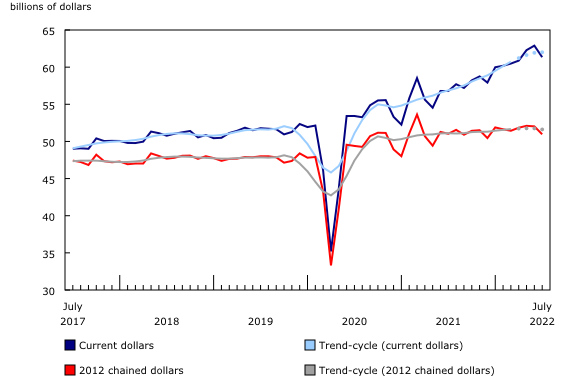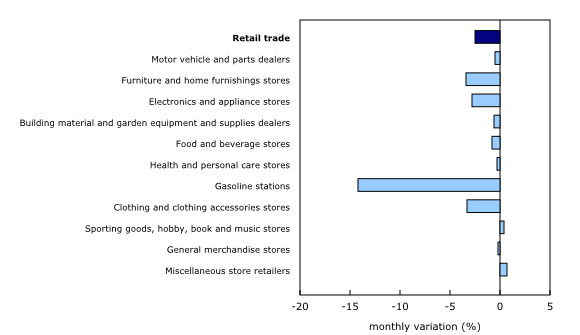Retail sales decreased 2.5% to $61.3 billion in July, the first decline observed in seven months. Sales were down in 9 of 11 subsectors, representing 94.5% of retail trade. The decrease was driven by lower sales at gasoline stations and clothing and clothing accessories stores.
Core retail sales—which exclude gasoline stations and motor vehicle and parts dealers—decreased 0.9%.
In volume terms, retail sales were down 2.0% in July.
Given the continually evolving economic situation, Statistics Canada is providing an advance estimate of retail sales, which suggests that sales increased 0.4% in August. Owing to its early nature, this figure will be revised. This unofficial estimate was calculated based on responses received from 51.1% of companies surveyed. The average final response rate for the survey over the previous 12 months has been 91.0%.
Chart 1
Retail sales decrease in July

Lower sales at gasoline stations and motor vehicle and parts dealers
Leading the decrease in retail sales in July were lower sales at gasoline stations (-14.2%), which recorded their first decline in seven months. In volume terms, sales at gasoline stations decreased 7.0%. Gasoline prices fell 9.2% on an unadjusted basis in July. Ongoing concerns related to a slowing global economy continued to put downward pressure on gas prices.
Sales at motor vehicle and parts dealers fell 0.5% in July. The decline was largely the result of lower sales at new car dealers (-0.6%). Lower sales were also reported at used car dealers (-1.7%) and automotive parts, accessories and tire stores (-0.9%). In contrast, other motor vehicle dealers (+2.4%) were the only store type in this subsector to increase.
Core retail sales decline
Core retail sales decreased 0.9% in July—the first decrease in seven months. Leading the decrease were sales at clothing and clothing accessories stores (-3.3%). The decrease was observed across all three store types in the subsector, with clothing stores (-3.3%) experiencing the largest decline.
Lower sales were also observed at food and beverage stores (-0.8%), which were led by a decline in supermarkets and other grocery (except convenience) stores (-0.9%) and beer, wine and liquor stores (-1.2%).
The largest increase to core retail came from miscellaneous store retailers, which increased 0.7%. Stores in this subsector include pet stores, cannabis stores and office supplies and stationery stores.
Chart 2
Sales decrease in 9 of 11 subsectors in July

Sales down in seven provinces
Retail sales decreased in seven provinces in July, led by lower sales in Ontario (-5.0%). Leading the decline in Ontario were lower sales at gasoline stations. Gasoline prices fell the most in Ontario, where the provincial government temporarily lowered the gasoline tax. In the census metropolitan area (CMA) of Toronto, retail sales fell 5.7%.
Lower retail sales were observed in Quebec (-1.5%). In the CMA of Montréal, sales fell 2.3%.
Retail sales were also lower in British Columbia (-1.5%), led by lower sales at gasoline stations. Retail sales were down 2.2% in the CMA of Vancouver.
Retail e-commerce sales in Canada
On a seasonally adjusted basis, retail e-commerce sales were down 0.7% in July.
On an unadjusted basis, retail e-commerce sales were up 4.3% year over year to $3.2 billion in July, accounting for 4.7% of total retail trade. The share of e-commerce sales out of total retail sales fell 0.1 percentage points compared with July 2021.













